
| Version | Summary | Created by | Modification | Content Size | Created at | Operation |
|---|---|---|---|---|---|---|
| 1 | Sirius Huang | -- | 1512 | 2022-10-18 01:40:37 |
Video Upload Options
The Southern African lion is a Panthera leo melanochaita population in Southern Africa. During the 20th century, lion populations in this part of Africa became fragmented and declined in several range countries due to loss of habitat and prey base, poaching and killing of lions to protect livestock and human life. In 2005, a Lion Conservation Strategy was developed for Southern and East Africa. Today, lion populations are stable only in large protected area complexes. In intensively managed protected areas in Botswana, Namibia, South Africa and Zimbabwe, they increased since the turn of this century. The scientific name P. l. melanochaita was proposed for the Cape lion in 1842 that was eradicated in the mid-19th century. P. l. melanochaita differs genetically from P. leo leo; the two subspecies probably diverged at least 50,000 years ago.
1. Characteristics
The lion's fur varies in colour from light buff to dark brown. It has rounded ears and a black tail tuft. Average head-to-body length of male lions is 2.47–2.84 m (8.1–9.3 ft) with a weight of 148.2–190.9 kg (327–421 lb). Females are smaller and less heavy.[1] The Cape lion had a black mane extending beyond the shoulders and under the belly.[2] Black-maned lions also occur in the Kalahari and eastern Okavango Delta alongside those with a normal tawny mane colour.[3] A few male Southern African lion skins in museum collections were described as having manes that vary in size, colour and development. Until the late 20th century, the colour and size of lion manes was considered to be a distinct subspecific characteristic.[4][5] In 2002, research in Serengeti National Park revealed that mane darkens with age; its colour and size are influenced by environmental factors like temperature and climate, but also by individual testosterone production, sexual maturity and genetic precondition. Mane length apparently signals fighting success in male–male relationships.[6]
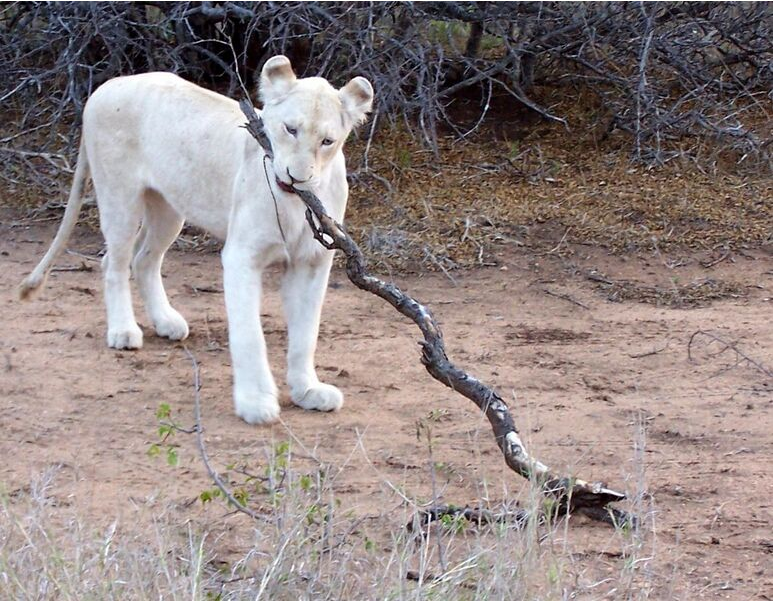
White lions have occasionally been encountered in and around Kruger National Park and the adjacent Timbavati Private Game Reserve in South Africa. Their whitish fur is a rare morph caused by a double recessive allele.[7]
2. Taxonomy
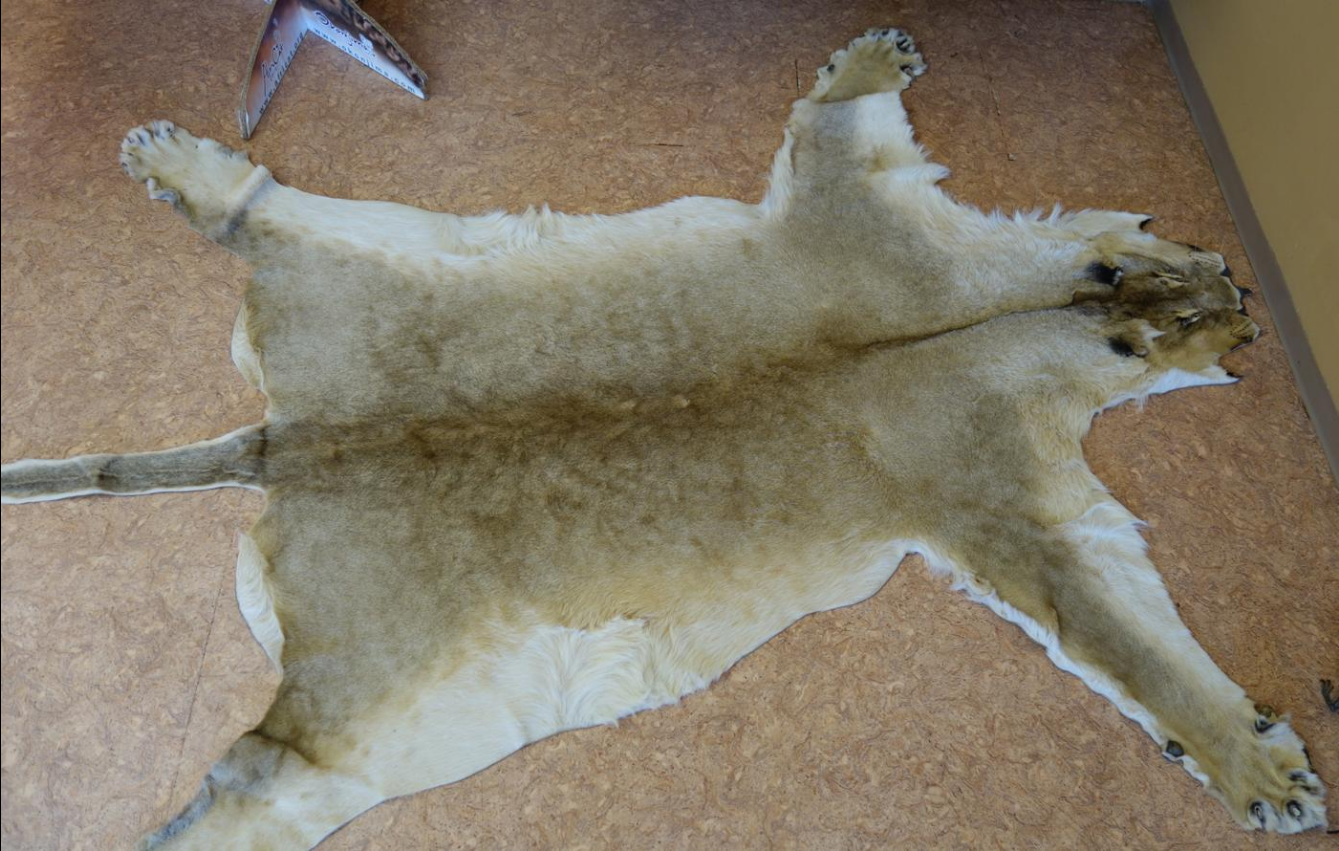
A lion from South Africa’s Cape Province was the type specimen for Felis (Leo) melanochaitus described in 1842 by Charles Hamilton Smith.[2] In the 19th and 20th centuries, several naturalists described zoological specimens from Southern Africa and proposed lion subspecies including:
- Felis leo bleyenberghi (Lönnberg 1914), a skin of a male lion from the Katanga Province in southern Belgian Congo[8]
- Leo leo krugeri (Austin Roberts 1929), a skin of an adult male lion from the Sabi Sand Game Reserve named in honour of Paul Kruger[9]
- Leo leo vernayi (Roberts 1948), a skin of a male lion from the Kalahari collected by the Vernay-Lang Kalahari Expedition[10]
Dispute over the validity of these purported subspecies continued among naturalists and curators of natural history museums until the early 21st century.[4][5][11][12]
In 2017, the Cat Classification Task Force of the IUCN Cat Specialist Group revised lion taxonomy based on results of phylogeographic research on lion samples. Two lion subspecies are now recognised:[13]
- P. l. melanochaita is understood as comprising lion populations in the contemporary Southern and East African range countries;
- P. l. leo comprises lion populations from North, West and Central Africa to Asia.
2.1. Genetic Research
Since the beginning of the 21st century, several phylogenetic studies were conducted to aid clarifying the taxonomic status of lion samples kept in museums and collected in the wild. Scientists analysed between 32 and 480 lion samples from up to 22 countries. They all agree that the species lion comprises two evolutionary groups, one in East and Southern Africa, and the other in the northern and eastern parts of its historical range; these groups diverged about 50,000 years ago. They assume that tropical rainforest and the East African Rift constituted major barriers between the two groups.[14][15][16][17][18][19]
In 2018, a lion recorded in Gabon's Batéké Plateau National Park was found to be closely related to historical lion specimens from this area and the neighbouring Republic of the Congo, which grouped with lion samples from Namibia and Botswana.[20]
3. Distribution and Habitat
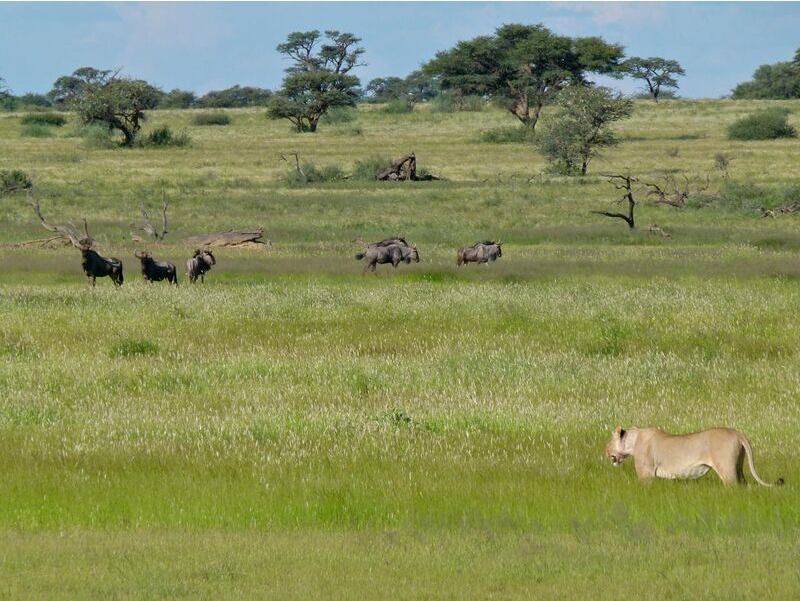
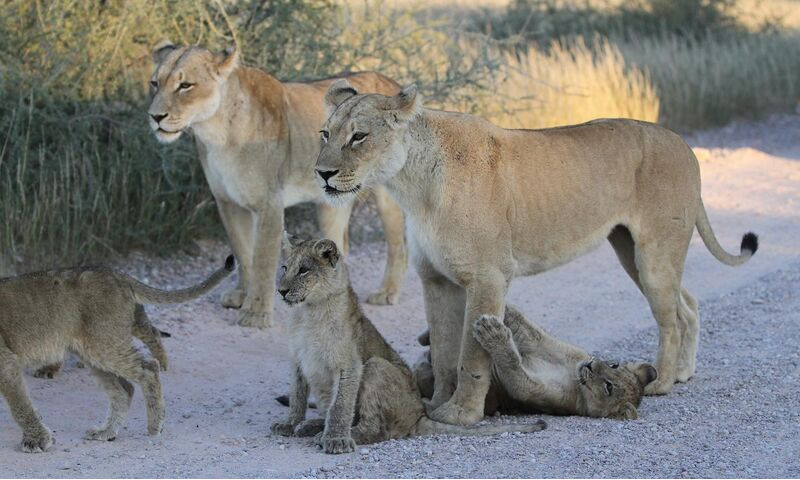
Southern African lion populations are confined to 23 unfenced and 16 fenced reserves today.[22] In the past, they declined in:
- Malawi and Zambia due to illegal hunting of prey species in protected areas.[23]
- Botswana due to intensive hunting and conversion of natural habitats for settlements since the early 19th century.[3]
- Namibia due to massive killing of lions by farmers since at least the 1970s.[24]
- South Africa since the early 19th century in the Natal and Cape Provinces south of the Orange River, where the Cape lion population was eradicated by 1860.[5] A few decades later, lions in the Highveld north of the Orange River were also eradicated.[1] In the Transvaal, lions occurred historically in the Highveld as well, but were restricted to eastern Transvaal’s Bushveld by the 1970s.[25]
Contemporary lion distribution and habitat quality in Southern Africa was assessed in 2005, and Lion Conservation Units (LCU) mapped.[26] Between 2002 and 2012, educated guesses for size of populations in the Southern African LCUs ranged from 13,482 to 12,036 individuals.[21][23]
| Range countries | Lion Conservation Units | Area in km2 |
|---|---|---|
| Tanzania, Mozambique | Niassa | 177,559[27] |
| Mozambique | Cahora Bassa, Gilé, Gorongosa-Marromeu | 82,715[27] |
| Mozambique, Zambia | Middle Zambezi | 64,672[27] |
| Mozambique, South Africa | Great Limpopo Transfrontier Park | 150,347[27] |
| Zambia | Liuwa Plains, Sioma Ngwezi, Kafue Sumbu Complex | 72,569[21] |
| Zambia, Malawi | North-South Luangwa | 72,992[21] |
| Malawi | Kasungu, Nkhotakota | 4,187[21] |
| Zimbabwe | Mapungubwe, Bubye | 10,033[21] |
| Botswana, Zimbabwe | Okavango-Hwange | 99,552[21] |
| Botswana | Xaixai | 12,484[26] |
| Botswana, South Africa | Kgalagadi | 163,329[21] |
| Angola | Kissama-Mumbondo, Bocoio-Camacuio, Alto Zambeze | 393,760[26] |
| Angola, Namibia | Etosha-Kunene | 123,800[26] |
| Namibia | Khaudum-Caprivi | 92,372[26] |
The LCUs Luangwa, Kgalagadi, Okavango-Hwange, Mid-Zambezi, Niassa and Greater Limpopo are currently considered lion strongholds in Southern Africa. They host more than 500 individuals each, and the population trend is stable.[21]
4. Ecology and Behaviour
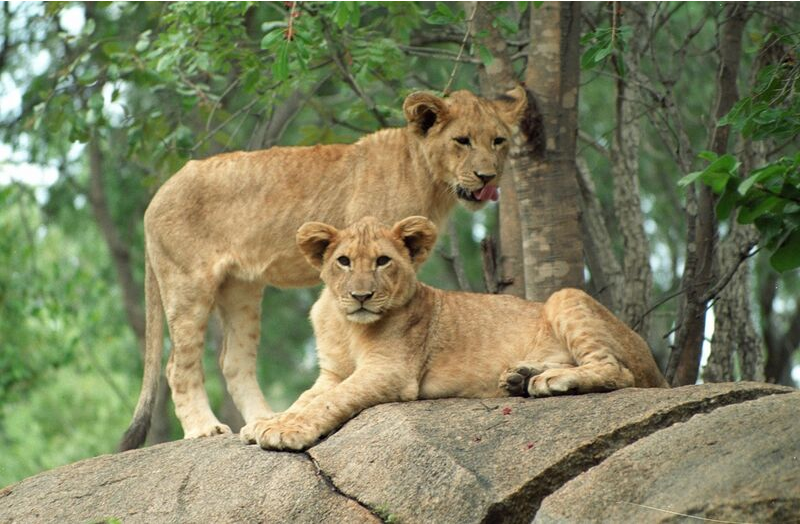
In Kruger National Park, lions have been monitored since the 1970s.[28] Results of a long-term study on hunting behaviour revealed that female lions were more successful at hunting medium-sized prey than male lions. Hunting success decreased in moon-lit nights and in areas with short grass.[29]
In Etosha National Park, 11 lion prides were observed between 1991 and 1996. Two of the prides had one male resident lion each, and two shared three males. The remaining prides had at least two males. Samples of 164 lions were analysed to figure out relatedness of pride members. Results showed that cubs born in prides with one male and sharing males had fathers that were not members of their pride.[30]
In Kavango–Zambezi Transfrontier Conservation Area, lions have been monitored since 1999. In 2003, 50 lions were radio-collared in Hwange National Park and tracked until 2012. Results show that adult male and female lions preferred grassland and shrubland habitat, but avoided woodlands and areas with high human density. By contrast, subadult dispersing male lions avoided grasslands and shrublands, but moved in human-dominated areas more frequently. Hence, dispersing lions are more vulnerable to coming into conflict with humans than adult lions.[31]
In Botswana’s Chobe National Park, African bush elephants dominate at waterholes during the dry season. Large prides of about 20 adult and subadult lions frequently attempt to capture elephants during this time and are successful particularly in moonless nights. Groups of three to five adult lions subdue and kill an elephant. Cubs join the hunting group when the elephant is dead.[32] In the Okavango Delta, lions swim in the delta's swamps and hunt large prey like Cape buffalo.[33]
5. Threats
Lion populations in Botswana, Namibia, Zimbabwe and Zambia are threatened by trophy hunting, loss and conversion of habitat. They became small and isolated because local people hunt prey species and kill lions in retaliation for livestock losses.[22] In Zambia's Kafue National Park, uncontrolled bushfires and hunting of lions and prey species makes it difficult for the lion population to recover. Cub mortality in particular is high.[34]
Between 2008 and 2013, bones and body parts from at least 2621 individual lions were exported from South Africa to Southeast Asia, and another 3437 lion skeletons between 2014 and 2016. Lion bones are used to replace tiger bones in traditional Asian medicines.[35] Private game ranches in South Africa breed lions for the canned hunting industry.[36]
In 2015 and 2017, two male lions, Cecil and his son Xanda, were killed by trophy hunters in Zimbabwe's Hwange National Park.[37][38]
6. Conservation
All lion populations in Africa are included in CITES Appendix II since 1975.[22] Because of the negative effect of trophy hunting, it was proposed in 2004 to list all lion populations in CITES Appendix I to reduce export of lion trophies and implement a stricter permission process.[39]
In 2006, a Lion Conservation Strategy for East and Southern Africa was developed in cooperation between IUCN regional offices and wildlife conservation organisations. The strategy envisages to maintain sufficient habitat and wild prey base, reduce factors that lead to further fragmentation of populations, and make lion-human coexistence sustainable.[26] Local communities in several Southern African lion range countries generate significant revenue through wildlife tourism, which is a strong incentive for their support of conservation measures.[22]
References
- Guggisberg, C.A.W. (1975). "Lion Panthera leo (Linnaeus 1758)". Wild Cats of the World. London: David and Charles. pp. 138–179. ISBN 0715371142.
- Smith, C. H. (1842). "Black maned lion Leo melanochaitus". in Jardine, W.. The Naturalist's Library. Vol. 15 Mammalia. London: Chatto and Windus. p. Plate X, 177. https://archive.org/stream/naturalistslibra15jardrich#page/176/mode/2up.
- Smithers, R.H.N. (1971). The Mammals of Botswana. Pretoria: University of Pretoria.
- Hemmer, H. (1974). "Untersuchungen zur Stammesgeschichte der Pantherkatzen (Pantherinae) Teil 3. Zur Artgeschichte des Löwen Panthera (Panthera) leo (Linnaeus, 1758)". Veröffentlichungen der Zoologischen Staatssammlung 17: 167–280. https://archive.org/stream/verfentlichungen171974zool#page/178/mode/2up.
- Mazak, V. (1975). "Notes on the Black-maned Lion of the Cape, Panthera leo melanochaita (Ch. H. Smith, 1842) and a Revised List of the Preserved Specimens". Verhandelingen Koninklijke Nederlandse Akademie van Wetenschappen (64): 1–44.
- West, P.M.; Packer, C. (2002). "Sexual Selection, Temperature, and the Lion's Mane". Science 297 (5585): 1339–1943. doi:10.1126/science.1073257. PMID 12193785. Bibcode: 2002Sci...297.1339W. https://dx.doi.org/10.1126%2Fscience.1073257
- Turner, J.A.; Vasicek, C.A.; Somers, M.J. (2015). "Effects of a colour variant on hunting ability: the white lion in South Africa". Open Science Repository Biology. doi:10.7392/openaccess.45011830. https://dx.doi.org/10.7392%2Fopenaccess.45011830
- Lönnberg, E. (1914). "New and rare mammals from Congo". Revue de Zoologie Africaine (3): 273–278. https://archive.org/stream/revuezoologiquea03brux#page/272/mode/2up.
- Roberts, A. (1929). "New forms of African mammals". Annals of the Transvaal Museum 21 (13): 82–121.
- Roberts, A. (1948). "Descriptions of some new subspecies of mammals". Annals of the Transvaal Museum 21 (1): 63–69.
- Allen, G. M. (1939). "Subgenus Panthera Oken". A Checklist of African Mammals. 83. Bulletin of the Museum of Comparative Zoology at Harvard College. pp. 242–274. https://archive.org/stream/bulletinofmuseum83harv#page/242/mode/2up.
- Wozencraft, W.C. (2005). "Panthera leo". in Wilson, D.E.; Reeder, D.M. Mammal Species of the World: A Taxonomic and Geographic Reference (3rd ed.). Johns Hopkins University Press. p. 546. ISBN 978-0-8018-8221-0. OCLC 62265494. http://www.departments.bucknell.edu/biology/resources/msw3/browse.asp?id=14000228.
- Kitchener, A. C.; Breitenmoser-Würsten, C.; Eizirik, E.; Gentry, A.; Werdelin, L.; Wilting, A.; Yamaguchi, N.; Abramov, A. V. et al. (2017). "A revised taxonomy of the Felidae: The final report of the Cat Classification Task Force of the IUCN Cat Specialist Group". Cat News Special Issue 11: 71–73. https://repository.si.edu/bitstream/handle/10088/32616/A_revised_Felidae_Taxonomy_CatNews.pdf?sequence=1&isAllowed=y.
- Barnett, R.; Yamaguchi, N.; Barnes, I.; Cooper, A. (2006). "The origin, current diversity and future conservation of the modern lion (Panthera leo)". Proceedings of the Royal Society B: Biological Sciences 273 (1598): 2119–2125. doi:10.1098/rspb.2006.3555. PMID 16901830. PMC 1635511. Archived from the original on 8 August 2007. https://web.archive.org/web/20070808182526/http://www.adelaide.edu.au/acad/publications/papers/Barnett%20PRS%20lions.pdf.
- Antunes, A.; Troyer, J.L.; Roelke, M.E.; Pecon-Slattery, J.; Packer, C.; Winterbach, C.; Winterbach, H.; Johnson, W.E. (2008). "The Evolutionary Dynamics of the Lion Panthera leo Revealed by Host and Viral Population Genomics". PLOS Genetics 4 (11): e1000251. doi:10.1371/journal.pgen.1000251. PMID 18989457. http://www.pubmedcentral.nih.gov/articlerender.fcgi?tool=pmcentrez&artid=2572142
- Mazák, J.H. (2010). "Geographical variation and phylogenetics of modern lions based on craniometric data". Journal of Zoology. doi:10.1111/j.1469-7998.2010.00694.x. ISSN 09528369. https://dx.doi.org/10.1111%2Fj.1469-7998.2010.00694.x
- Bertola, L.D.; Van Hooft, W.F.; Vrieling, K.; Uit De Weerd, D.R.; York, D. S.; Bauer, H.; Prins, H. H. T.; Funston, P.J. et al. (2011). "Genetic diversity, evolutionary history and implications for conservation of the lion (Panthera leo) in West and Central Africa". Journal of Biogeography 38 (7): 1356–1367. doi:10.1111/j.1365-2699.2011.02500.x. http://dspace.learningnetworks.org/bitstream/1820/4311/1/2011_Bertola,Hooft,Vrieling,Weerd,York,Bauer,Prins,Haes,Iongh_GeneticDiversityEvolutionaryHistoryAndImplicationsForConservationOfTheLionInWestAndCentralAfrica.pdf.
- Dubach, J.M., Briggs, M.B., White, P.A., Ament, B.A., & Patterson, B.D. (2013). "Genetic perspectives on “Lion Conservation Units” in Eastern and Southern Africa". Conservation Genetics 14 (4): 741−755.
- Bertola, L.D.; Jongbloed, H.; Van Der Gaag, K.J.; De Knijff, P.; Yamaguchi, N.; Hooghiemstra, H.; Bauer, H.; Henschel, P. et al. (2016). "Phylogeographic patterns in Africa and High Resolution Delineation of genetic clades in the Lion (Panthera leo)". Scientific Reports 6: 30807. doi:10.1038/srep30807. PMID 27488946. PMC 4973251. Bibcode: 2016NatSR...630807B. https://www.nature.com/articles/srep30807?WT.feed_name=subjects_evolution.
- Barnett, R., Sinding, M.H., Vieira, F.G., Mendoza, M.L., Bonnet, M., Araldi, A., Kienast, I., Zambarda, A., Yamaguchi, N., Henschel, P., Gilbert, M.T. (2018). "No longer locally extinct? Tracing the origins of a lion (Panthera leo) living in Gabon". Conservation Genetics 19 (3): 1−8. doi:10.1007/s10592-017-1039-2. https://dx.doi.org/10.1007%2Fs10592-017-1039-2
- Riggio, J.; Jacobson, A.; Dollar, L.; Bauer, H.; Becker, M.; Dickman, A.; Funston, P.; Groom, R. et al. (2013). "The size of savannah Africa: a lion’s (Panthera leo) view". Biodiversity and Conservation 22 (1): 17–35. doi:10.1007/s10531-012-0381-4. https://link.springer.com/article/10.1007/s10531-012-0381-4.
- Template:IUCN
- Chardonnet, P. (2002). "Chapter II: Population Survey". Conservation of the African Lion : Contribution to a Status Survey. Paris: International Foundation for the Conservation of Wildlife, France & Conservation Force, USA. pp. 21–101. http://conservationforce.org/pdf/conservationoftheafricanlion.pdf.
- Stander, P.E. (1990). "A suggested management strategy for stock-raiding lions in Namibia". South African Journal of Wildlife Research 20 (2): 37−43. ISSN 2410-7220. http://www.worldcat.org/issn/2410-7220
- Rautenbach, I.L. (1978). "Ecological distribution of the mammals of the Transvaal (Vertebrata: Mamalia)". Annals of the Transvaal Museum 31 (10): 131−156. https://journals.co.za/docserver/fulltext/nfi_annalstm/31/10/203.pdf.
- IUCN Cat Specialist Group (2006). Conservation Strategy for the Lion Panthera leo in Eastern and Southern Africa. Pretoria, South Africa: IUCN.
- Chardonnet, P.; Mésochina, P.; Renaud, P.-C.; Bento, C.; Conjo, D.; Fusari, A.; Begg, C.; Foloma, M. et al. (2009). Conservation status of the lion (Panthera leo Linnaeus, 1758) in Mozambique. Maputo, Mozambique.
- Smuts, G. L., Hanks, J., and Whyte, I. J. (1978). "Reproduction and social organization of lions from the Kruger National Park". Carnivore 1 (1): 17−28.
- Funston, P. J., Mills, M.G.L., Biggs, H.C. (2001). "Factors affecting the hunting success of male and female lions in the Kruger National Park". Journal of Zoology (253): 419−431.
- Lyke, M.M., Dubach, J., & Briggs, M.B. (2013). "A molecular analysis of African lion (Panthera leo) mating structure and extra-group paternity in Etosha National Park". Molecular Ecology 22 (10): 2787–2796.
- Elliot, N.B., Cushman, S.A., Macdonald, D.W. and Loveridge, A.J. (2014). "The devil is in the dispersers: predictions of landscape connectivity change with demography". Journal of Applied Ecology 51 (5): 1169–1178.
- Power, R.J.; Compion, R.X.S. (2009). "Lion predation on elephants in the Savuti, Chobe National Park, Botswana". African Zoology 44 (1): 36–44. doi:10.3377/004.044.0104. https://www.researchgate.net/publication/232693088.
- Main, D. (2013-11-26). "Photos: The Biggest Lions on Earth". Live Science. https://www.livescience.com/41584-photos-the-biggest-lions-on-earth.html.
- Midlane, N. (2013). The conservation status and dynamics of a protected African lion Panthera leo population in Kafue National Park, Zambia (PhD). University of Cape Town. hdl:11427/9308. //hdl.handle.net/11427%2F9308
- Williams, V.L., Loveridge, A.J., Newton, D.J. and Macdonald, D.W. (2017). "A roaring trade? The legal trade in Panthera leo bones from Africa to East-Southeast Asia". PLOS One 12 (10): e0185996. doi:10.1371/journal.pone.0185996. PMID 29065143. Bibcode: 2017PLoSO..1285996W. http://www.pubmedcentral.nih.gov/articlerender.fcgi?tool=pmcentrez&artid=5655489
- Schroeder, R.A. (2018). "Moving Targets: The ‘Canned’ Hunting of Captive-Bred Lions in South Africa". African Studies Review 61 (1): 8–32. doi:10.1017/asr.2017.94. https://dx.doi.org/10.1017%2Fasr.2017.94
- "Zimbabwe's 'iconic' lion Cecil killed by hunter". BBC News. 2015. Archived from the original on 28 July 2015. https://web.archive.org/web/20150728220149/http://www.bbc.com/news/world-africa-33674087.
- "Xanda, son of Cecil the lion, killed by hunter in Zimbabwe". BBC News. 2017. https://www.bbc.com/news/world-africa-40671590.
- Nowell, K. (2004). "The Cat Specialist Group at CITES 2004". Cat News 41: 29.




